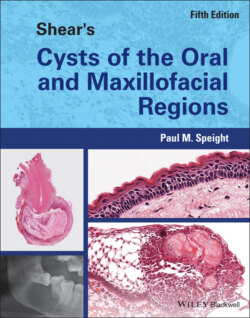Читать книгу Shear's Cysts of the Oral and Maxillofacial Regions - Paul M. Speight - Страница 42
Radiological Features
ОглавлениеThe classic description of the radiological appearance of radicular cysts is that they are round or ovoid radiolucencies surrounded by a narrow, radiopaque or corticated margin that extends from the lamina dura of the involved tooth (Figure 3.4; see also Figure 2.2). In infected or rapidly enlarging cysts, the corticated margin may not be present. A residual cyst is usually round to oval with a well‐demarcated and often corticated margin. They are found within an edentulous area of the jaws, at a site of a previous tooth extraction (Figure 3.5). With a residual cyst, the differential diagnosis of keratocyst must be considered. A radicular cyst on the lateral margin of a root in association with an accessory root canal must be differentiated from a lateral periodontal cyst. Root resorption is not often seen on routine radiographs, but it may occur.
Despite these well‐described features, many studies have shown that it is not possible to reliably differentiate radiologically between a radicular cyst and a periapical granuloma. In one of the largest studies, which has not been repeated, Mortensen et al. (1970 ) examined histological material of 396 periapical lesions with a diameter of 5 mm or more, that had been classified pre‐operatively as cysts or granulomas on radiological evidence. A correct preliminary diagnosis had been made in 81% of 232 granulomas, but in only 48% of 164 cysts. They also showed that the relative number of granulomas decreased with increasing size of the lesion, whereas the relative number of cysts increased. Table 3.1 summarises their data and shows that if a lesion measured between 10 and 14 mm in radiographic diameter, there was an equal chance of it being a granuloma or a cyst. About one‐third of lesions measuring 5–9 mm were cysts and one‐third of lesions measuring 15 mm or more were granulomas. However, they found that very large lesions, over 20 mm, were almost always cysts, a finding confirmed by others (Natkin et al. 1984 ).
Figure 3.4 Radiograph of a radicular cyst. The lesion is a well‐defined radiolucency associated with the apex of a non‐vital root‐filled tooth.
Mortensen et al. (1970 ) also noted that many cysts had a diffuse radiographic margin and therefore lacked the cortication often described as typical for radicular cysts. This suggested that a corticated margin, although common, was not a specific diagnostic criterion for a cyst, a finding supported by others. Ricucci et al. (2006a ) examined 57 periapical radiolucent lesions and found that of 10 lesions with a corticated outline, only 3 were cysts. Conversely, 40 of the 47 lesions without cortication were granulomas.
Figure 3.5 Radiograph of a residual cyst. The lesion is at the site of a previously extracted tooth. The lesion must be differentiated from an odontogenic keratocyst.
Table 3.1 The relationship between the size of a lesion on radiological examination and the histological diagnosis of a cyst or granuloma. The arrow illustrates the increasing chance of a lesion being a cyst.
Source: Based on Mortenson et al. (1970 ).
Shrout et al. (1993 ) used radiometric methods to analyse the grey levels on digitised images of periapical lesions. In a pilot study of only 10 mandibular lesions, they showed that analysis of grey levels could correctly identify 4 of 6 granulomas and all 4 cysts. They concluded that it may be feasible to differentiate between radicular cysts and periapical granulomas on the basis of radiographic density. With the advent of digital radiography and powerful software to routinely analyse images, it would be interesting to see if these findings could be confirmed. Early studies examining grey levels on images from cone beam computed tomography (CBCT) suggest that this may provide an accurate diagnosis (Simon et al. 2006 ). Measurement of conventional parameters on CBCT, however, have proved to be no more accurate than conventional X‐rays (Guo et al. 2013 ).
Although teeth may be resorbed by radicular cysts, there is a poor correlation between radiological evidence of resorption and actual tooth resorption on histology. Laux et al. (2000 ) compared the radiological and histological findings in 114 periapical lesions. Ninety three (81%) showed histological evidence of tooth resorption, but only 21 (19%) showed evidence of resorption on the radiographs. It should be noted, however, that only 30 of the 93 lesions with histological resorption showed dentine involvement. In the majority (63 cases) only cementum was involved and it was acknowledged that this would not normally be visible on a plain radiograph.
The data from these studies suggest that there are no specific radiological features that can be used to distinguish between a radicular cyst and a periapical granuloma. Clinicians know that it is useful in treatment planning to have an indication, a priori, whether a periapical lesion is a cyst or a granuloma. There are a number of key features that together can identify that a lesion is odontogenic and can be highly suggestive of a cyst (Box 3.2). Both granulomas and cysts are associated with a heavily restored or carious tooth and lie within the periodontal ligament. Cysts are more often over 15 mm in diameter, more often have a corticated margin, and show a greater degree of radiopacity.
